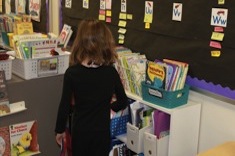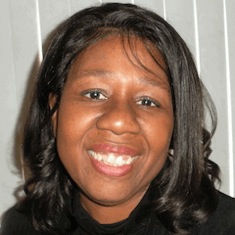A few weeks ago, Kim and Lily were snuggled in a beanbag chair with their heads together. They were trying to decipher some troublesome words in a book.
“Sat? Seat?” tried Kim.
“What about that w? You didn’t say anything with the w sound,” Lily said.
“Sa-wet?” Kim tried again.
After a few more attempts, Lily said, “Let’s put this one back and get the good one.”
Lily crawled out of the beanbag chair and marched across the room. She came back with a copy of Pete the Cat: I Love My White Shoes tucked under her arm. Several times—not just once—the girls joyfully “sang-read” through the entire book. Then the teacher rang the chimes. The girls put their book away and scurried off to “Working with Words.”
Kim and Lily were originally trying to read Pete the Cat and the Bad Banana, one of the “beginning reader” offerings in the Pete the Cat series. Pete the Cat is a favorite book character in their first-grade classroom, so their teacher thought it would be a good idea to get some of the beginning reader books featuring Pete for the classroom library. I can certainly understand her thinking. A beginning reader book is easy. The print is larger. The sentences are shorter. There is a lot of white space on the page. It’s a good genre for supporting emergent and early readers—right?
Somehow, things weren’t quite working out. The girls had absolutely no difficulty reading the picture book, but the beginning reader book, which is theoretically easier, had stumped them. What was the problem? Exactly what is the difference between a picture book and a beginning reader book? Which is the better option for novice readers? When do we offer a beginning reader book, and when do we offer a picture book?
What Are Beginning Readers?
Beginning readers, also called “easy readers,” is a category of books specifically designed for children in the early stages of reading acquisition. Many publishers have their own collection of these books with its own special name such as “I Can Read,” “Step into Reading,” “Hello Reader,” or “Green Light Readers.” Many of these illustrated books come with a recommended reading level from kindergarten through third grade.
In an effort to make the books easy to read, a number of concessions are made. A writing formula is used that affects the number of words that can occur in a sentence, the type of words that can be used, the number of syllables in the words, the sentence structure, and the sentence length. These restrictions can be challenging for most writers, often resulting in stilted, unnatural language. As a result, the efforts to make the books easier sometimes actually make them harder, because early readers cannot rely on their own knowledge of language structures to support them in reading these books.
Fortunately, not all beginning reader books suffer from this drawback. Gifted writers such as Tedd Arnold (Fly Guy), Cynthia Rylant (Henry and Mudge), Arnold Lobel (Frog and Toad), Mo Willems (Elephant and Piggie), and Else Minarik (Little Bear) are able to overcome the restrictions and create wonderful stories.
What Are Picture Books?
A picture book is a book in which the illustrations are critical to the telling of the story. Picture books are typically 28–40 pages long. In picture books, there are illustrations on every page or on one of every pair of facing pages. There are no grade-level recommendations, and the books can be written at any readability level. There are also no restrictions on word choice, sentence structure, or sentence length. When a parent or a teacher reaches for a book to read aloud to children, it is likely to be a picture book.
Which Book in What Circumstances?
Beginning reader books are no longer the exclusive realm of Sammy the Seal, Morris and Boris, and Biscuit. The current trend in children’s book publishing is to take a favorite picture character and create a collection of beginning reader books featuring that character. Fancy Nancy, Pete the Cat, Pinkalicious, and Splat the Cat now all star in their own beginning reader books. Favorite characters from movies such as Frozen, Marley and Me, Batman, Superman, and Spider-Man can also be found in beginning reader books. Novice readers get really excited at the prospect of reading a book featuring a favorite character from movies, television, and picture books. But proceed with caution.
Kim and Lily were able to read Pete the Cat: I Love My White Shoes (the picture book) because it had been read aloud to them many times. This book was easy for them to read because of its familiarity and features other than word choice, sentence length, and sentence structure. It uses rhyme, rhythm, and repetition, making it predictable and accessible. Even though the book has tricky words like stepped, turn, and worry, the girls sailed right through the reading without a problem. However, the words tasty and sweet in the beginning reader book taxed their word-solving abilities. There wasn’t sufficient support available to help them over the hurdle.
There is a right time to offer beginning reader books. They might be a good option for a small-group session when the teacher is there to scaffold the reading or when the child is reading the book with another competent reader. After the children have had a scaffolded reading experience, the book can be made available for independent reading. It would also have been helpful if the teacher had done a book talk when she introduced the book to the classroom library. Just a little bit of information about what the novice readers would encounter in the book might have made a difference.
Picture books are also excellent independent reading choices after they have been read aloud. The children know what the text is supposed to say. Therefore, matching the print to their memory of the story might even help to increase reading vocabulary.
Choosing the Best Beginning Readers
Beginning reader books can be important tools for supporting children in becoming proficient readers. Strive to select only the best books to offer your novice readers. If our young readers are going to put in the effort necessary to read the book, let’s make it worth their while. In particular, don’t allow the lure of favorite characters to seduce you into choosing books that don’t meet the right educational criteria. Although favorite characters might make novice readers excited about the prospect of reading a particular book, it will ultimately provide very little benefit if the book is not well written. Here are some suggestions that might guide your selections:
- Adhere to the same standards that you have for selecting any book: good plot, well-developed and likable characters with personality, and a satisfying ending.
- Look for books by authors who have demonstrated competence in writing engaging stories within the confines of the beginning reader restrictions.
- Watch out for books that overuse phonetically regular words to support novice readers. English is more than 35 percent irregular. Novice readers need to develop strategies for dealing with that fact.
- Check out the Theodor Seuss Geisel Award list. These award-winning books are written especially for novice readers.
- Do you like the book? If you aren’t delighted, your students won’t be either. Take a pass.



